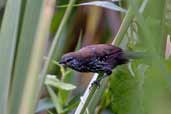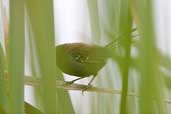(aka Parana Antwren Stymphalornis acutirostris)

October 2005
Some authorities have included this species as Parana Antwren Stymphalornis acutirostris which was described as recently as 1995 by Bornschein, Reinert and Teixera and is restricted to a small area on the coast of Paraná and Santa Catarina in south-east Brazil. However, in 2013 Dante Buzetti et al. made the formal description of Marsh Antwren Formicivora paludicola as a new species. Given the highly restricted area and small population it is classified as Critically Endangered by Birdlife International.

The discover of this new population / new species took place in February 2005.
My translation into English of this press release from the University of São Paulo is as follows:
"The São Paulo version of the Marsh Antbird lived undisturbed in the green belt of the city of São Paulo until, in February 2005,
it was identified as a new species of the genus Stymphalornis. From that moment on, it didn't have a minute's peace. The reason was
that the habitat of the only population known at that time was to be flooded for the construction of the Paraitinga reservoir, creating a great
danger for these creatures.
Immediately the discoverer of the bird, the biologist, Luís Fábio Silveira of the University of São Paulo, together with his team, did everything possible to capture as many individuals as they could and release them in areas with similar vegetation, typha (cattails) marshland. "It is the first time in South America that this procedure, called re-location, has been used for insect-eating passeriforms", explained the scientist.
Since there is almost no literature on it, the procedure required special care. "We will monitor all the transferred populations for a year to ensure that they have adapted well to their new habitats." Silveira kept both IBAMA and the São Paulo Water and Electricity Department informed and they both followed and supported the project.
In total 72 individuals were captured (35 males and 37 females), all transferred to 12 nearby localities with similar ecosystems, giving priority to protected areas. Silveira states that the approach, although a bit drastic, had to be taken because some characteristics of the species indicated that its population was very small. "It is restricted to a habitat that is not very common in the region."
In parallel, another population of the species was located by the biologist Dante Buzetti in the region between Mogi das Cruzes and Arujá, near to the locality where it was first discovered. However, since the area did not present immediate risks, the creatures did not need to be relocated.
New Species
Silveira is now working on the formal description of the new species so that it can be formally recognised by the scientific community. Since it has
not yet been described scientifically, it does not have a specific scientific name receiving in the meantime the denomination Stymphalornis sp.
nov.. Initially it was thought to be the species S. acutirostris, known as Marsh Antwren (or Parana Antwren) endemic to the coast of
Paraná and Santa Catarina.
With precautions for the preservation of the birds taken it is hoped that the re-location of them will be successful and that the project will provide valuable information for future conservation programmes. The discovery of the birds was announced officially on 5th May 2005 by IBAMA who intend to include it in its list of endangered species."
| Previous Page | Back to Index | Next Page |